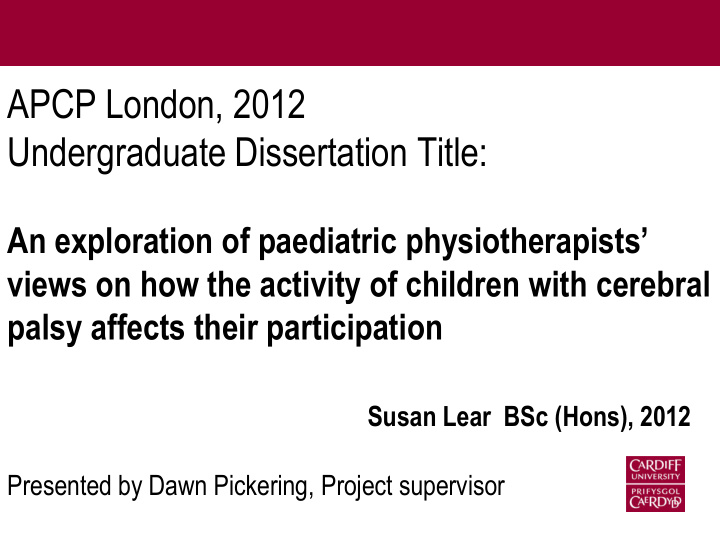



APCP London, 2012 Undergraduate Dissertation Title: An exploration of paediatric physiotherapists’ views on how the activity of children with cerebral palsy affects their participation Susan Lear BSc (Hons), 2012 Presented by Dawn Pickering, Project supervisor
Objective To explore paediatric physiotherapists views about participation by children with CP • Literature review-Look at the evidence • Why participation is important • Factors influencing participation • Collect data
Literature review ICF (WHO, 2001; ICF CY 2004) Participation in leisure activities seen as key outcome by children with cerebral palsy (Bult et al, 2011) Participation rarely features as a physiotherapy outcome measure (Coombe et al, 2011) SPARCLE project (Colver et al, 2010) Welsh and English reports
ICF - Contextual Factors Cerebral Palsy Skeletal Alignment Mobility Community, ROM - Fitness Self-Care Social and Civic Life Public Attitude Age – Gender Accessibility Interests (WHO, 2001, 2004)
Activity “The execution of a task or an action by an individual”
Participation “Someone's involvement in life situations” Play, Entertainment, Sports, Culture, Crafts, Hobbies and Social activities including religious expressions
Welsh and English reports • Fair play for disabled children and young people in Wales (Bevan Foundation 2011) • Centre of Excellence and Outcomes in Children‟s and Young People‟s Services (C4EO) (Beresford and Clark, 2009)
Bevan Foundation Questionnaire survey, activity groups: Ice Cool Kids(skiing), Pedal Power(adapted cycling) Play Wales „….. belief that disabled children need care rather than play…’ Children‟s commissioners report – „… disabled children want to do things without their parents or carers…’
Centre of Excellence and Outcomes in Children’s and Young People’s Services (C4EO) • What do disabled children want from play and leisure services? To see their existing friends and make new ones More choice as to where and how they spend their free time To be able to access the support they need to pursue their own leisure interests.
C4EO - Findings • Some families need active support to identify and join positive activities
Participation Link between the amount of participation : • Severity of disability • Number of limbs affected • Degree of spasticity (Kerr et al, 2007) • Participation in leisure activities is an important outcome for children with disabilities (Majnemer et al, 2008)
Physiotherapy Interventions Limited evidence supporting one intervention over another (Barber, 2008; Levitt, 2010) Outcome measures linked to body function (Coombe at al, 2011) Not conclusive that strength training improves ability to participate (Scianni et al, 2009)
Research Method • Qualitative 3 Semi Structured Interviews with paediatric physiotherapists exploring: Are there preferred treatment approaches to achieve participation? What do physiotherapists do to foster participation?
Thematic analysis • 4 themes emerged : – Treatments – Activity – Participation – Barriers and Facilitators
Treatments • Influence of physiotherapists wider than purely physical treatment Education – Parents – Carers – Teachers
Activity and Participation Limited attention was given directly to participation Enhancing movement and activity was expected to translate into increased participation The measure of success appeared to be the participation rather than any resultant and measurable improvement in quality of life.
Barriers: Attitudes “... the activity level of the child isn’t the limiting factor in participation...to participate in something is much more involved than just what that child can do physically… ”
Opportunities to succeed “….we need to assess whether it’s possible to accommodate that child, before we just drop the child into a situation where they will possibly fail and where they will not have a positive experience…”
Facilitators • “….I think activity is a prerequisite of participation. I think a lot of children can’t participate because they haven’t got enough levels of activity . So, you’ve got to adapt the activity to a level so that the child can succeed, and whatever that level is it doesn’t matter because they can improve ….”
Discussion • There are few targeted interventions to improve participation • Physiotherapists spend most time on body functions and structure, some on activity • There are many factors that influence participation including people‟s attitudes
Summary • Participation is influenced by many factors and receives limited specific attention by physiotherapists • Interventions and measurement focus on body functions and structure, and activity • Physiotherapists - pivotal role in educating and providing support to foster participation
Future suggestions • Physiotherapists should consider measuring participation as an outcome as this is important to children and young people with CP • Creating opportunities for participation requires active effort in partnership with the 3 rd sector
“ A disability isn’t always a disability. It’s only a disability if it makes that child not participate. ”
Questions? Email: pickeringdm@cf.ac.uk
References • See separate word document
Recommend
More recommend